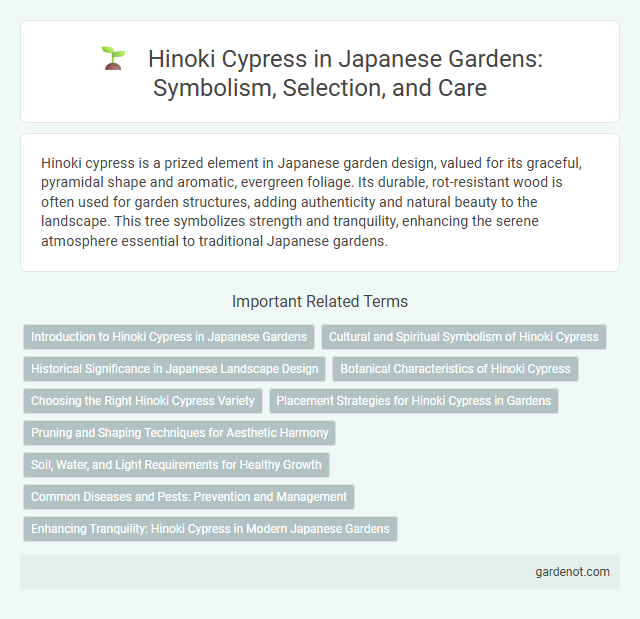Hinoki cypress is a prized element in Japanese garden design, valued for its graceful, pyramidal shape and aromatic, evergreen foliage. Its durable, rot-resistant wood is often used for garden structures, adding authenticity and natural beauty to the landscape. This tree symbolizes strength and tranquility, enhancing the serene atmosphere essential to traditional Japanese gardens.
Introduction to Hinoki Cypress in Japanese Gardens
Hinoki cypress (Chamaecyparis obtusa) is a prized evergreen tree native to Japan, renowned for its fragrant wood and gracefully tiered branches that symbolize purity and tranquility in Japanese gardens. This species thrives in humid, temperate climates and is often used as a focal point or natural screen due to its elegant shape and dense, dark green foliage. Its durable timber is traditionally valued in temple construction, while its presence in garden design enhances the serene atmosphere central to Japanese aesthetic principles.
Cultural and Spiritual Symbolism of Hinoki Cypress
Hinoki cypress (Chamaecyparis obtusa) holds profound cultural and spiritual significance in Japanese gardens, symbolizing purity, longevity, and protection. Its aromatic wood is traditionally used in Shinto shrines and temples to embody sacredness and divine presence. Revered for its resilience and elegance, Hinoki cypress reflects harmony with nature and serves as a living emblem of spiritual tranquility.
Historical Significance in Japanese Landscape Design
Hinoki cypress (Chamaecyparis obtusa) holds profound historical significance in Japanese landscape design, revered for centuries as a symbol of purity and longevity. Traditional Japanese gardens often incorporate Hinoki wood for temple architecture, bridges, and garden structures, reflecting its esteemed status and spiritual importance. Its durable, aromatic wood and elegant form contribute to the serene aesthetic and cultural heritage central to classical Japanese garden artistry.
Botanical Characteristics of Hinoki Cypress
Hinoki cypress (Chamaecyparis obtusa) is an evergreen conifer native to Japan, prized for its dense, dark green foliage and aromatic wood. The species features scale-like leaves arranged in flat sprays, with bark that is reddish-brown and peels in vertical strips. Hinoki cypress can grow up to 35 meters tall, thriving in well-drained, acidic soils, and is highly resistant to rot, making it a valued plant in Japanese garden design and traditional architecture.
Choosing the Right Hinoki Cypress Variety
Selecting the ideal Hinoki cypress variety for a Japanese garden depends on factors such as growth rate, size, and foliage color. Varieties like Chamaecyparis obtusa 'Nana Gracilis' offer compact growth and dense, dark green foliage ideal for bonsai or small garden spaces. For larger gardens, 'Fernspray Gold' provides elegant, golden-hued foliage that contrasts beautifully against traditional greenery.
Placement Strategies for Hinoki Cypress in Gardens
Strategic placement of Hinoki cypress in Japanese gardens enhances tranquility and visual balance by positioning the tree near water features or koi ponds, where its elegant form reflects on the surface. Integrating Hinoki cypress along stone pathways or near tea houses creates natural focal points, emphasizing the garden's spiritual and aesthetic harmony. Grouping Hinoki cypress with moss and ferns in shaded areas accentuates textured contrasts and deepens the garden's layered composition.
Pruning and Shaping Techniques for Aesthetic Harmony
Hinoki cypress pruning in Japanese gardens employs precise techniques to maintain its natural elegance and enhance structural balance. Selective trimming emphasizes the tree's tiered branch arrangement, promoting light penetration and air circulation while preserving its iconic fan-shaped foliage. Shaping focuses on gentle tapering and smooth contours to achieve aesthetic harmony with surrounding elements such as moss, stone lanterns, and water features.
Soil, Water, and Light Requirements for Healthy Growth
Hinoki cypress thrives in well-drained, slightly acidic to neutral soils rich in organic matter, ensuring optimal root health and growth. Consistent moisture is essential; the soil should remain evenly moist but not waterlogged to prevent root rot. It prefers partial shade to full sun exposure, with filtered light ideal for maintaining vibrant foliage in Japanese garden settings.
Common Diseases and Pests: Prevention and Management
Hinoki cypress (Chamaecyparis obtusa) in Japanese gardens is commonly affected by root rot caused by Phytophthora species and needle blight from fungal pathogens. Preventive measures include ensuring well-drained soil and avoiding waterlogged conditions to reduce fungal infection risks. Regular inspection for aphids, scale insects, and spider mites, combined with timely application of horticultural oils or insecticidal soaps, effectively manages pest infestations.
Enhancing Tranquility: Hinoki Cypress in Modern Japanese Gardens
Hinoki cypress (Chamaecyparis obtusa) enhances tranquility in modern Japanese gardens through its aromatic, evergreen foliage and natural resistance to pests, promoting a serene atmosphere year-round. The wood's soft texture and subtle fragrance contribute to a multisensory experience, reinforcing traditional aesthetics and a calming environment. Its slow growth and elegant form provide structure and harmony, essential elements in Japanese garden design.
Hinoki cypress Infographic

 gardenot.com
gardenot.com